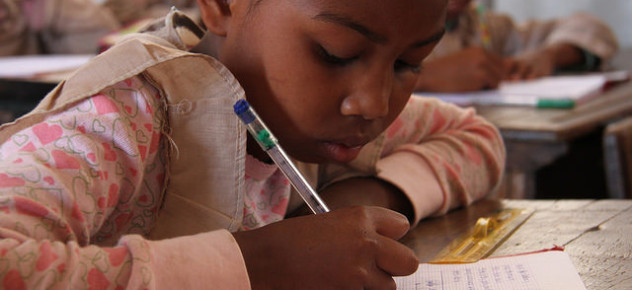
School canteens will help attract and keep pupils in the classroom, and improve their results. Credit: Stephanie Malyon / CIAT
Madagascar is known for its sunny beaches and scuba diving. What many probably don’t know is that it is also among the world’s least developed countries. Nine out of ten Malagasy people live below the poverty threshold, according to a 2013 World Bank report. And the political crisis that hit the country between 2009 and 2013 did further damage to the economy, increasing poverty and marginalization.
Half of Malagasy children are stunted due to chronic malnutrition and severe micronutrient deficiencies. To combat this problem, a team led by the Office for National Nutrition (ONN) and involving several ministries is kicking off an ambitious program across the entire country.
The new program involves a revival of the national school feeding system, which was abandoned in 2009 due to the political crisis. A 5-month pilot was carried at a primary school in the capital, Antananarivo, during 2013 to demonstrate the potential impact on child nutrition.
During the pilot, pupils received a nutritious breakfast three mornings a week consisting of porridge produced locally specially for the school canteen and composed of 40% bean flour, 28% maize flour, 17% soya flour, 15% sugar, and added vitamins and micronutrients. Results showed improvements in the children’s weight as well as a substantial reduction in school absenteeism – from an average of 10 days a month to just 2 days.
Dody Rasoahoby, national education director in the region of Analamanga, said: “The standards of living are very low in Madagascar, and children go to school without eating breakfast. School canteens will really help us attract and keep pupils in the classroom.”

Community nutrition officers raise families’ awareness of issues related to vaccination, hygiene, and nutrition. Credit: Stephanie Malyon / CIAT
Rodah Zulu, a CIAT nutrition facilitator based in Malawi, explained, however, that to really fight malnutrition and stunting, intervention needs to take place during the first 1,000 days of life, i.e., between conception and 2 years.
The national program also involves the creation of community nutrition centers, where activities are organized to inform and support families, and especially monitor mothers and young children under age 2. There, families learn about vaccination, hygiene, and nutrition, and also how to cultivate a kitchen garden and prepare nutritious food. There are more than 6,000 such centers in the whole country.
The traditional Malagasy diet is dominated by rice. Beans nutritionally complement rice and are widely grown in rotation with the crop across Madagascar.
The red marble-seeded bean variety (CAL98) that was used in the pilot is known for its high protein, iron, and zinc content, which are sorely missing in the Malagasy people’s diet. In the future, partners in Madagascar’s nutrition program plan to replace CAL98 with a biofortified variety, i.e., a variety with even higher iron and zinc content. Such beans are the result of research carried out as part of the CGIAR HarvestPlus Program, in collaboration with the Pan-Africa Bean Research Alliance (PABRA), which is coordinated by CIAT and to which Madagascar belongs through its National Center for Applied Research on Rural Development (FOFIFA by its Malagasy acronym). In 2014, FOFIFA imported 45 bean varieties through PABRA for testing and selected 20 that are now undergoing multi-site trials to ensure they grow well in Madagascar.

Madagascar’s National Center for Applied Research on Rural Development, FOFIFA, is performing variety trials to select new, biofortified varieties of beans that can grow well in Madagascar. Credit: Stefanie Neno / CIAT
Modeste Second Volombola, a researcher at the Agronomy Research Department of FOFIFA said: “If any of the varieties newly introduced happens to be superior to CAL98, we can use it in the future for the school canteens. If not, we’ll stick to CAL98.”
With plans for school canteens to be implemented at the national level, FOFIFA and partner farmers are already prepared to provide ONN with CAL98 beans in sufficient quantities. Farmers Rodine and Roselyne, for instance, each received 600 grams of CAL98 seeds from FOFIFA in 2006. They then multiplied and started selling certified seeds to local seed companies in order to create a market for the product. This activity, along with egg production, enables the two women to complement the incomes of their husbands, who both work as drivers in the city.
“I’m really happy that ONN chose to use beans for the school feeding program,” confided CIAT’s Rodah Zulu. “This will not only benefit pupils but also small-scale farmers in Madagascar. It will improve their income and, indirectly, improve child nutrition in rural areas.”

The school feeding program can improve child nutrition but also school attendance and the pupils’ performance. Credit: Stephanie Malyon / CIAT
Mihoby, 9, who attends the Ampasandratsarahoby school in Antananarivo, wants to be a doctor when she grows up. Her favorite class is science. Thanks to the nutrition program, she learned that food contains micronutrients that are essential for growth and health. She even learned how to grow vegetables in the school’s kitchen garden.
Partners in this initiative want to give Mihoby and all pupils in Madagascar the chance to study under better conditions, realize their dreams, and develop their country. Now, it’s a matter of finding the necessary funds to implement the school feeding program across the country.